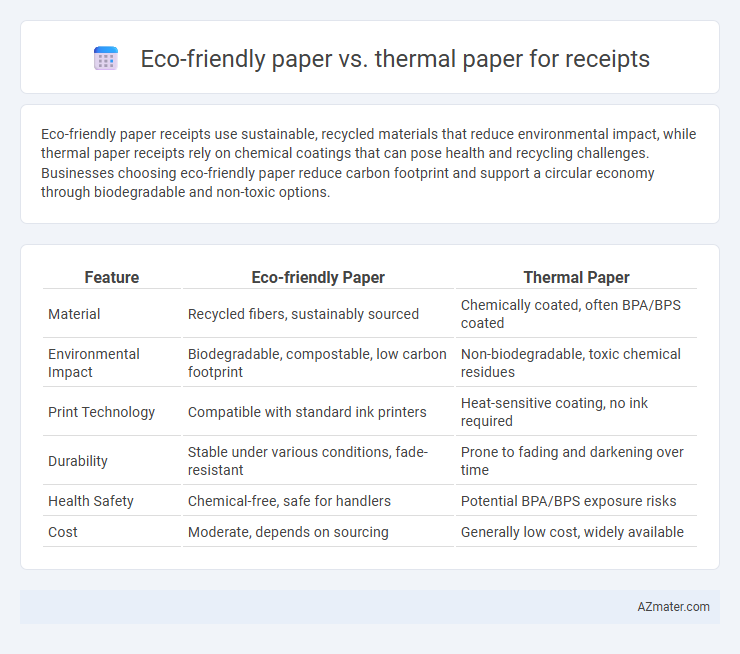Eco-friendly paper receipts use sustainable, recycled materials that reduce environmental impact, while thermal paper receipts rely on chemical coatings that can pose health and recycling challenges. Businesses choosing eco-friendly paper reduce carbon footprint and support a circular economy through biodegradable and non-toxic options.
Table of Comparison
| Feature | Eco-friendly Paper | Thermal Paper |
|---|---|---|
| Material | Recycled fibers, sustainably sourced | Chemically coated, often BPA/BPS coated |
| Environmental Impact | Biodegradable, compostable, low carbon footprint | Non-biodegradable, toxic chemical residues |
| Print Technology | Compatible with standard ink printers | Heat-sensitive coating, no ink required |
| Durability | Stable under various conditions, fade-resistant | Prone to fading and darkening over time |
| Health Safety | Chemical-free, safe for handlers | Potential BPA/BPS exposure risks |
| Cost | Moderate, depends on sourcing | Generally low cost, widely available |
Introduction to Receipt Papers
Receipt papers are essential materials used in point-of-sale systems, with eco-friendly paper and thermal paper being the primary types. Eco-friendly paper is made from sustainable sources and often utilizes soy-based or vegetable-based inks, reducing environmental impact compared to traditional thermal paper. Thermal paper relies on heat-sensitive coatings for printing without ink, commonly used for quick, high-volume printing but raising concerns due to the presence of BPA or BPS chemicals.
What is Eco-Friendly Paper?
Eco-friendly paper is made from sustainable sources such as recycled materials or certified forests, reducing environmental impact by minimizing deforestation and chemical usage. This type of paper is typically free from harmful substances like BPA and BPS, which are commonly found in thermal paper, making it safer for both human health and the environment. Its production process emphasizes energy efficiency and reduced waste, contributing to lower carbon emissions compared to traditional thermal receipts.
Understanding Thermal Paper
Thermal paper is coated with chemicals that react to heat, enabling instant printing without ink, but it often contains BPA or BPS, raising environmental and health concerns. Eco-friendly paper alternatives use biodegradable materials and avoid harmful chemicals, reducing ecological impact and improving recyclability. Choosing thermal paper without toxic coatings or switching to eco-friendly receipts supports sustainable business practices while maintaining print quality.
Environmental Impact Comparison
Eco-friendly paper receipts significantly reduce environmental impact by using recycled fibers and avoiding harmful chemicals like BPA and BPS, which are commonly found in thermal paper. Compared to thermal paper, eco-friendly options generate less landfill waste and have a lower carbon footprint due to sustainable sourcing and biodegradable properties. Thermal paper's chemical coatings hinder recycling efforts and contribute to pollution, making eco-friendly paper a more sustainable choice for businesses aiming to minimize their ecological footprint.
Health and Safety Concerns
Eco-friendly paper receipts eliminate harmful chemicals like bisphenol A (BPA) and bisphenol S (BPS), which are commonly found in thermal paper and linked to endocrine disruption and other health risks. Thermal paper, widely used for receipts, can transfer these chemicals to skin upon contact, raising concerns about long-term exposure for consumers and retail workers. Choosing eco-friendly, BPA-free paper reduces chemical exposure, promotes safer handling, and supports overall public health.
Cost Analysis: Eco-Friendly vs Thermal
Eco-friendly paper receipts typically incur higher upfront costs due to the use of sustainable materials and environmentally safe inks, but they offer long-term savings by reducing disposal fees and environmental compliance expenses. Thermal paper receipts have lower initial costs and faster printing speeds but can contribute to higher environmental cleanup and health-related costs because of BPA and BPS chemical coatings. Choosing eco-friendly paper supports corporate social responsibility goals and potential tax incentives, balancing initial expenses against sustainable brand value and regulatory benefits.
Durability and Print Quality
Eco-friendly paper for receipts offers superior durability due to its resistance to fading, smudging, and tearing compared to traditional thermal paper. Thermal paper relies on heat-sensitive coatings prone to discoloration over time and under exposure to heat or light, compromising print longevity. Print quality on eco-friendly paper remains clear and sharp longer, supporting better record-keeping and reducing waste associated with reprinting.
Recyclability and Disposal
Eco-friendly paper for receipts is designed with biodegradable and recyclable materials, allowing it to break down easily in recycling processes and reducing landfill waste. Thermal paper often contains BPA or BPS chemicals, which complicate recycling efforts and require special disposal methods to avoid environmental contamination. Choosing eco-friendly paper enhances recyclability and supports sustainable disposal practices, minimizing ecological impact compared to conventional thermal paper.
Regulatory Compliance and Certifications
Eco-friendly paper receipts often comply with stringent environmental regulations and possess certifications like FSC (Forest Stewardship Council) and PEFC (Programme for the Endorsement of Forest Certification), ensuring sustainable sourcing and reduced ecological impact. Thermal paper, frequently treated with BPA or BPS chemicals, faces increasing regulatory scrutiny, leading to restrictions in certain regions such as the EU and California, to protect consumer health and the environment. Businesses selecting receipt paper must consider compliance with local and international standards, including REACH in Europe and FDA guidelines in the U.S., to ensure safety and sustainability.
Choosing the Right Receipt Paper for Your Business
Selecting the right receipt paper is crucial for businesses aiming to balance sustainability and functionality. Eco-friendly paper, often made from recycled materials and free from harmful chemicals, reduces environmental impact and aligns with corporate responsibility goals. Thermal paper, known for its crisp printing and durability, may contain BPA or BPS, raising health and environmental concerns, making eco-friendly alternatives a preferable choice for businesses seeking greener solutions.

Infographic: Eco-friendly paper vs Thermal paper for Receipt
 azmater.com
azmater.com